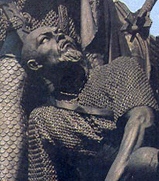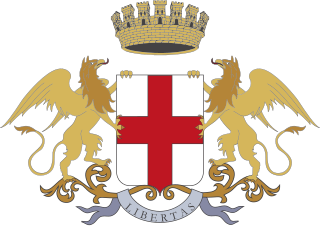
Mamai was a powerful Mongol military commander of the Golden Horde. Contrary to popular misconception, he was not a khan (king), but was a kingmaker for several khans, and dominated parts or all of the Golden Horde for a period of almost two decades in the 1360s and 1370s. Although he was unable to stabilize central authority during the war of succession known as the Great Troubles, Mamai remained a remarkable and persistent leader for decades, while others came and went in rapid succession. His defeat in the Battle of Kulikovo marked the beginning of the decline of the Horde, as well as his own rapid downfall.

Feodosia, also called in English Theodosia, is a city on the Crimean coast of the Black Sea. Feodosia serves as the administrative center of Feodosia Municipality, one of the regions into which Crimea is divided. During much of its history, the city was a significant settlement known as Caffa or Kaffa. According to the 2014 census, its population was 69,145.

The Republic of Genoa was a medieval and early modern maritime republic from the years 1099 to 1797 in Liguria on the northwestern Italian coast. During the Late Middle Ages, it was a major commercial power in both the Mediterranean and Black Sea. Between the 16th and 17th centuries, it was one of the major financial centres in Europe.

Sudak is a city, multiple former Eastern Orthodox bishopric and double Latin Catholic titular see. It is of regional significance in Crimea, a territory recognized by most countries as part of Ukraine but annexed by Russia as the Republic of Crimea. Sudak serves as the administrative center of Sudak Municipality, one of the regions Crimea is divided into. It is situated 57 km (35 mi) to the west of Feodosia and 104 km (65 mi) to the east of Simferopol, the republic's capital. Population: 16,492 .

Gazaria was the name given to the colonial possessions of the Republic of Genoa in Crimea and around the Black Sea coasts in the territories of the modern regions of Russia, Ukraine and Romania, from the mid-13th century to the late 15th century. The Genoese rule was represented by a consul, and the capital of the Gazaria was the city of Kaffa in the Crimean peninsula.

The Venetian–Genoese Wars were four conflicts between the Republic of Venice and the Republic of Genoa which took place between 1256 and 1381. Each was resolved almost entirely through naval clashes, and they were connected to each other by interludes during which episodes of piracy and violence between the two Italian trading communities in the Mediterranean Sea and the Black Sea were commonplace, in a "cold war" climate.

Niccolò Polo and Maffeo Polo were Italian traveling merchants from the Republic of Venice, best known as the father and uncle, respectively, of the explorer Marco Polo. The brothers went into business before Marco's birth, established trading posts in Constantinople, Sudak in Crimea, and in a western part of the Mongol Empire in Asia. As a duo, they reached modern-day China before temporarily returning to Europe to deliver a message to the Pope. Taking Niccolò's son Marco with them, the Polos then made another journey through Asia, which became the subject of Marco's account The Travels of Marco Polo.
The Peace of Turin of 1381, ended the War of Chioggia (1376–81), in which Venice, allied with Cyprus and Milan, had narrowly escaped capture by the forces of Genoa, Hungary, Austria, Padua and the Patriarchate of Aquileia. Venice had overcome this crisis, forcing the surrender of the Genoese fleet at Chioggia, fighting a second Genoese fleet to a standstill in the Adriatic, and turning Austria against Padua, thus forcing its most threatening landward opponent into retreat. However, the war had been extremely costly for Venice, and it was only able to secure peace by making major concessions to its opponents.
Oberto Doria was an Italian politician and admiral of the Republic of Genoa, ruling the republic as Capitano del popolo.

The Battle of Settepozzi was fought in the first half of 1263 off the Greek island of Settepozzi between a Genoese–Byzantine fleet and a smaller Venetian fleet.

The Genoesecolonies were a series of economic and trade posts in the Mediterranean and Black Seas. Some of them had been established directly under the patronage of the republican authorities to support the economy of the local merchants, while others originated as feudal possessions of Genoese nobles, or had been founded by powerful private institutions, such as the Bank of Saint George.

Giovanni di Murta was elected the second Doge of the Republic of Genoa after the resignation of Simone Boccanegra, on 25 December 1345. His dogate was dominated by his attempts to break the circle of political violence which had crippled the city over the past century and to reassert Genoese dominion over the Mediterranean colonies.

Giovanni II Valente was the third doge of the Republic of Genoa. His time in office was marked by the crushing defeat of the city against the Venetians at the naval Battle of Alghero. Giovanni had already asked to succeed the first doge of the Republic in December 1345 but had turn down the responsibility.

The Genoese navy was the naval contingent of the Republic of Genoa's military. From the 11th century onward the Genoese navy protected the interests of the republic and projected its power throughout the Mediterranean and Black Seas. It played a crucial role in the history of the republic as a thalassocracy and a maritime trading power.

The War of Curzola was fought between the Republic of Venice and the Republic of Genoa due to increasing hostile relations between the two Italian republics. Spurred largely by a need for action following the commercially devastating Fall of Acre, Genoa and Venice were both looking for ways to increase their dominance in the Eastern Mediterranean and Black Sea. Following the expiration of a truce between the republics, Genoese ships continually harassed Venetian merchants in the Aegean Sea.
Guglielmo Boccanegra was a Genoese statesman, the first capitano del popolo of the Republic of Genoa, from 1257 to 1262, exercising a real lordship, assisted in the government by a council of 32 elders.
The Genoese–Mongol Wars were a series of conflicts fought between the Republic of Genoa, the Mongol Empire and its successor states, most notedly the Golden Horde and Crimean Khanate. The wars were fought over control of trade and political influence in the Black Sea and Crimean peninsula during the 13th, 14th and 15th centuries.

The Siege of Caffa was a 14th-century military encounter when Jani Beg of the Golden Horde sieged the city of Caffa, between two periods in the 1340s. The city of Caffa, a Genoese colony, was a vital trading hub located in Crimea. The city was then part of Gazaria, a group of seven ports located in Crimea and belonging to the maritime empire of the Republic of Genoa. The event is historically significant primarily because it is believed to be one of the earliest instances of biological warfare.

The Venetian slave trade refers to the slave trade conducted by the Republic of Venice, primarily from the Early Middle Ages to the Late Middle Ages. The slave trade was a contributing factor to the early prosperity of the young Republic of Venice as a major trading empire in the Mediterranean Sea.

The Genoese slave trade refers to the slave trade conducted by the Republic of Genoa, which was a major business during primarily the Middle Ages.









